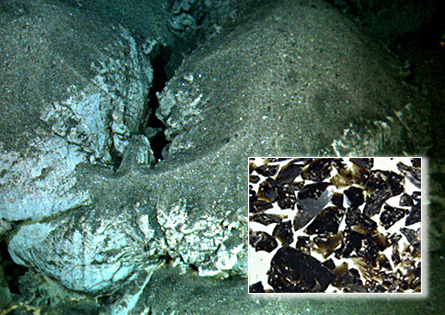
© Reves-Sohn et al.; A. Soule and C. Willis/WHOI
A two-week cruise on an icebreaker to the top of the world last summer gave scientists a look at the aftermath of an event once thought impossible: a violent volcanic eruption on the deep-sea floor.
In 1999, a global network of seismic instruments detected the largest swarm of earthquakes ever to occur along the planet's system of mid-ocean ridges, where tectonic plates spread to form new ocean crust. Several aspects of the recorded vibrations suggested that the quakes were generated by volcanic activity, says Robert A. Reves-Sohn, a geophysicist at the Woods Hole Oceanographic Institution in Massachusetts.
However, he notes, many scientists have doubted that explosive volcanism can take place at the 4,000-plus-meter depth where these quakes occurred because the immense pressure of overlying water prevents seawater from flashing into steam, a major driving force for such eruptions.
The source of the quakes was the Gakkel Ridge, a mid-ocean ridge that runs along the bottom of the Arctic Ocean. Sonar scans at a stretch of the ridge about 500 kilometers from the North Pole revealed several distinctive volcanic features, says Reves-Sohn. The largest of these undersea features, which usually have flat tops scarred with prominent central craters, are about 2 kilometers across and a few hundred meters tall.
Images gathered by a remotely operated vehicle show that the ocean floor is blanketed by layers of loose volcanic ash up to 10 centimeters thick. This material is piled on top of rocks and other high-standing features on the ocean floor, a sign that the jagged, glassy particles of ash - each typically measuring no more than a couple of millimeters across - gently rained down upon the ocean floor rather than sweeping down the flanks of the undersea volcanoes, Reves-Sohn says.
He and his colleagues don't know the full extent of the volcanic deposits, but they did find ash in all parts of the 5-by-10-kilometer area that they surveyed, they report in the June 23
Nature.
The size and shape of the larger particles hint that one of the area's undersea volcanoes spewed 1-kilometer-tall fountains of lava during an explosive eruption. When that molten material hit the near-freezing seawater, it quickly chilled into golf-ball-size chunks and then fractured into tiny bits that rained to the seafloor, Reves-Sohn speculates. Many of the ash bits are jagged, thin, Christmas-ornament-like fragments of glass, a testament to the violence of the eruption and the bubbles contained in the molten material.
Because steam couldn't have driven the eruption, the volcano must have been fueled by another volatile component of the magma, the researchers say. The most likely culprit, says Reves-Sohn, is carbon dioxide. The amount of gas needed to fuel a deep-sea eruption like the ones that occurred along the Gakkel Ridge, however, is about 100 times the amount normally found dissolved in molten rock, he notes.
The tectonic plates at most mid-ocean ridges spread apart about 30 millimeters each year, around the same rate at which a fingernail grows. However, the Gakkel Ridge is an ultra-slow spreading center where the plates diverge only half that fast. Whereas volcanic eruptions in many shallow seafloor locales may occur every 10 years or so, eruptions at deep-sea, slow-spreading centers may happen only once every 10,000 years or so, Reves-Sohn speculates. If so, sufficient reservoirs of carbon dioxide can easily build up in the magma chambers beneath the undersea peaks.
Such a scenario for deep-sea eruptions is "quite plausible," says James W. Head III, a geoscientist at Brown University in Providence, R.I. The profuse deposits of ash along the Gakkel Ridge "are a big find," he notes, adding that apparently "things don't happen often at slow-spreading centers, but when an eruption occurs there's a lot going on."
Reader Comments
to our Newsletter